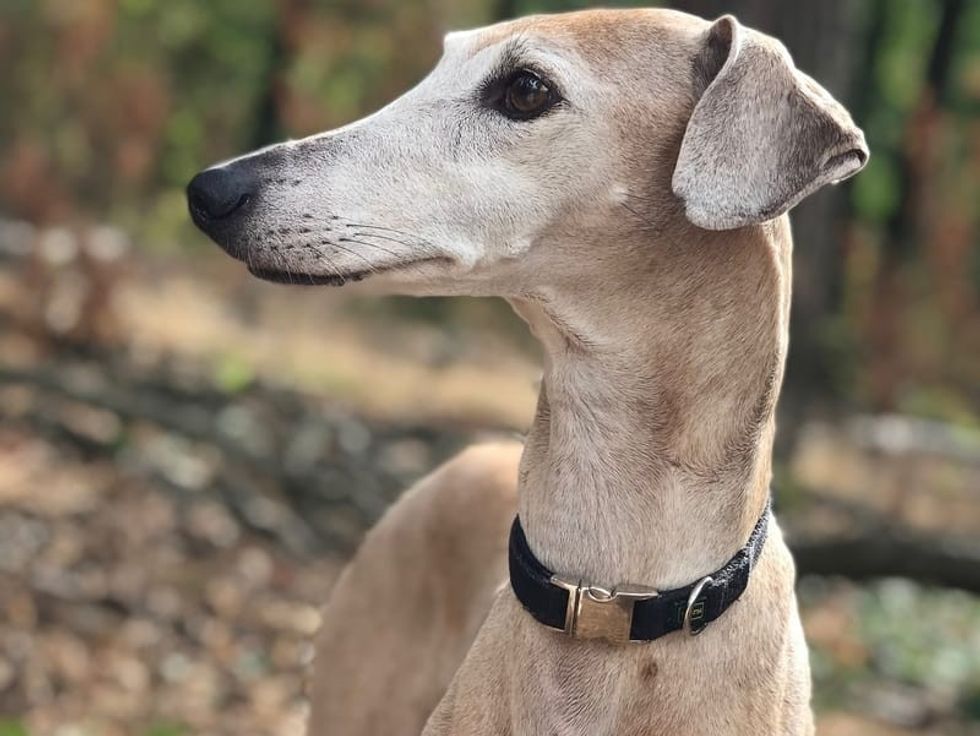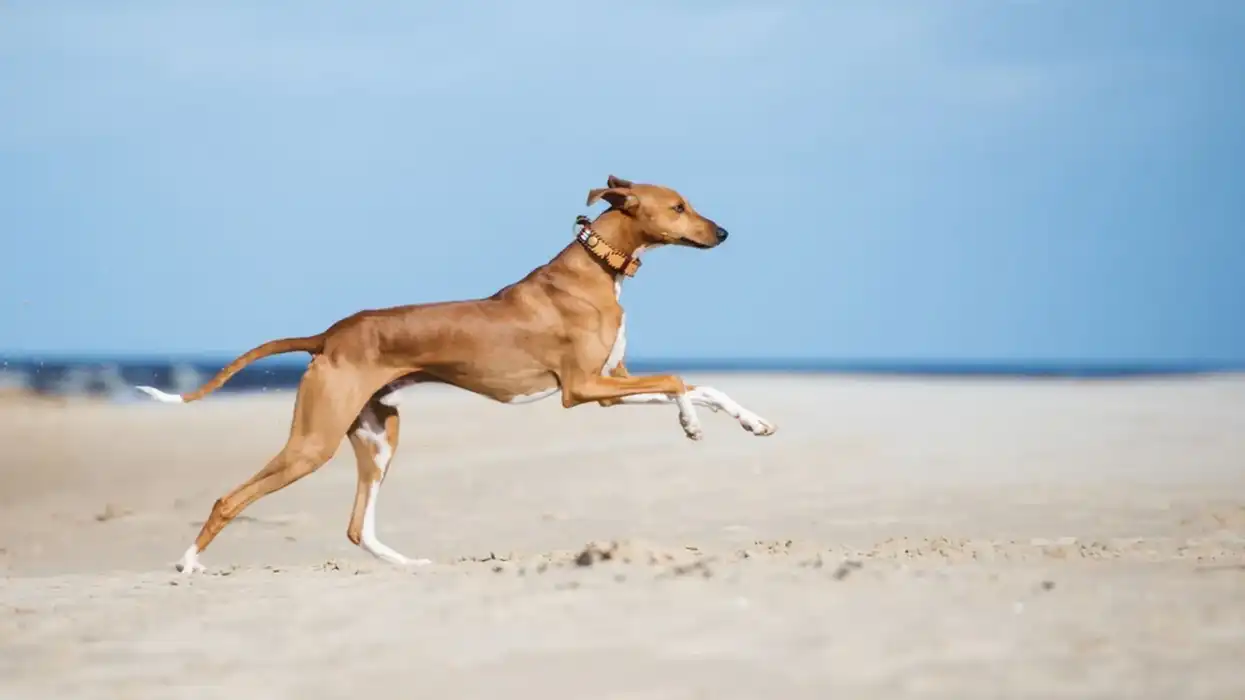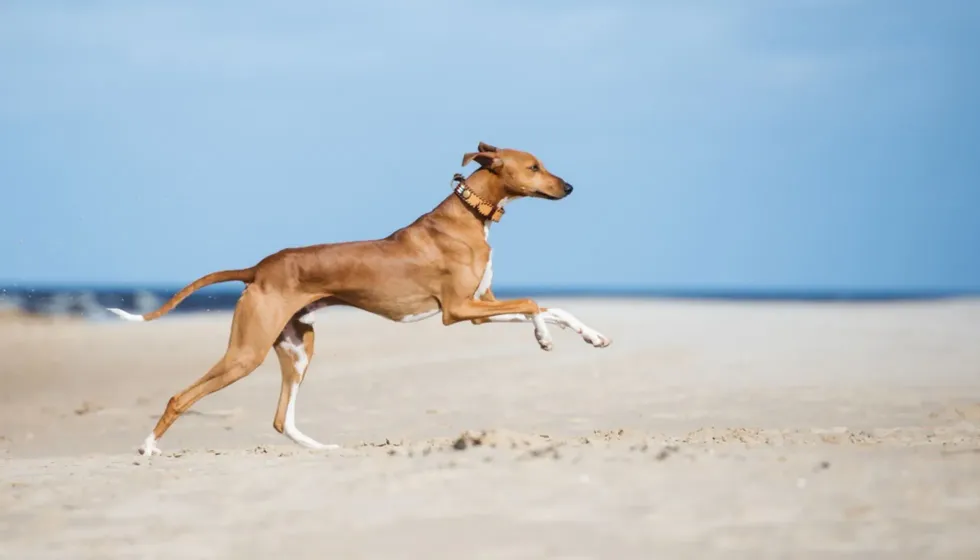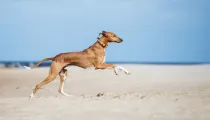Fun Azawakh Facts For Kids

Content
- What type of animal is an Azawakh?
- What class of animal does an Azawakh belong to?
- How many Azawakhs are there in the world?
- Where does an Azawakh live?
- What is an Azawakh's habitat?
- Who do Azawakhs live with?
- How long does an Azawakh live?
- How do they reproduce?
- What is their conservation status?
- What do Azawakhs look like?
- How cute are they?
- How do they communicate?
- How big is an Azawakh?
- How fast can an Azawakh run?
- How much does an Azawakh weigh?
- What are the male and female names of the species?
- What would you call a baby Azawakh?
- What do they eat?
- Are they slobbery?
- Would they make a good pet?
- Did you know...
- How to pronounce Azawakh
- What AKC group is the Azawakh in?
An Azawakh is a sighthound native to West Africa. This breed is native to the Sahel region and was used as hunting dogs by the nomadic tribes of Mali, Burkina Faso, Algeria, Niger, and Azawakh Valley.
The Azawakh dog breed with long legs has adaptation features to cope with its native West African semi-desert habitat near the Sahara Desert.
These fiercely loyal dog breed with a calm temperament was mostly owned by the nomadic Tuareg tribe. They called the dog Tuareg Sloughi or idii n’ illeli, meaning ‘sighthound of the free people.’
The Azawakh dog breeds are closely connected to the Sloughi and the Saluki. Sloughi is a North African dog breed, while the Saluki is a sighthound believed to be a gift from God by the nomadic tribes and ethnic groups like the Tuareg, Hausa, Peulh, and Bella.
These loyal dogs show a calm temperament around their homes, but can be standoffish or aloof to strangers. These pack dogs have a high prey drive. The Azawakh is an ancient breed that existed for thousands of years.
Mostly cattle breeding nomadic tribes of the South and West Africa owned them. The Azawakh dog breed was considered a companion, guardian, and hunter.
You may also check out whippet facts and Shikoku facts from Kidadl.
Azawakh Interesting Facts
What type of animal is an Azawakh?
Azawakh is a dog breed from West Africa. These sighthounds were mostly owned by nomadic tribes and ethnic groups like the Tuaregs who inhabit regions of Libya, Algeria, Niger, Burkina Faso, and Mali.
What class of animal does an Azawakh belong to?
Azawakh dogs belong to the class Mammalia.
How many Azawakhs are there in the world?
It is difficult to say how many African dog breed Azawakh are there in the world. Although, not too many Azawakh dogs are left in their homeland in the Sahel region of Africa. It is one of the rare dog breeds and thousand of these sighthound dogs are estimated to be living in different parts of the world.
Where does an Azawakh live?
Azawakh were bred as guard dogs and hunting dogs by African nomadic tribes. They usually lived in packs with their human owners in villages and were considered guardians of the people.
What is an Azawakh's habitat?
The homeland of the Azawakh dog breed is the arid regions of the southern Sahara Desert. Like other dog breeds of the African arid region – like the Sloughi or the Arabian greyhound – Azawakh dogs are not big fans of humid or cold weather.
The African dog Azawakh has a short coat that is almost missing at the underbelly is suited to live in hot weather. Azawakh puppies have extremely good dry and heat tolerance.
Who do Azawakhs live with?
Azawakh is an ancient dog breed native to West Africa. They were companions of nomadic tribes and ethnic groups like the Tuareg clan living across the Sahara. These dogs lived in packs in the village.
This sighthound breed was bred to guard and hunt. Their job was to chase down and catch speedy prey like wild boar, hare, antelope, and other game animals. With their superior vision, they can spot strangers or animals approaching the village from a long distance and alert their pack with loud barks.
At present, Azawakh is a popular rare dog breed kept as a pet in homes. Azawakh puppies are some of the most expensive in the world. This dog has gained recognition by the American Kennel Club (AKC). With its AKC acceptance, these puppies of African origin are now eligible to take part in competitions in recognized dog shows.
How long does an Azawakh live?
Azawakh hounds have a lifespan of 12-15 years.
How do they reproduce?
Azawakh dogs usually have a single annual estrus or are in heat once a year. Being a dog breed originating from the rough and difficult weather of the Sahara, they are tough and independent. The female can give unassisted birth to healthy Azawakh puppies. Mostly four to six puppies are born. However, litter size may vary from 1-10.
What is their conservation status?
Although the number of African aboriginal Azawakh dogs is not too many in the world, they are a prized possession. These dogs are not listed to be a threatened species in any way by the IUCN.
Azawakh Fun Facts
What do Azawakhs look like?

The Azawakh dog breed is a sighthound. That means these dogs use their sense of sight more than their sense of smell to track their prey. A true hound, these dogs have long legs and a slender body with prominent hip bones. The elegant Azawakh sighthounds give an overall impression of great fineness and speed.
The bone structure of this dog breed is somewhat visible through the coat. Their skin fits tightly over the whole body. The dogs are taller than they are long.
Like most dog breeds originating from hot regions, Azawakhs have short, fine hair. Hair is almost negligible at the belly. Dark brown, sable, red, clear sand, brindle combinations – Azawakh's coat can be of different hues and all are accepted by the American Kennel Club. Coat colors can also be fawn with freckles.
The head may have a black mask. There is a bib-like white marking on the neck and underbelly. They also have white markings at the tip of the tail.
All four limbs have a stocking-like white marking. A black brindle coat is allowed by the American Kennel Club to enter competitions. They have a flat back.
The long legs make the hips placed at a higher elevation compared to the withers. These dogs have a distinctly cat-like (feline) gait. When they run, they have a double suspension gallop and an upright movement.
The skinny dogs have expressive eyes, a long neck, and are 24–29 in (60–74 cm) tall. The female Azawakh dogs are slightly lighter than the males. These dogs weigh around 33–55 lb (15-25 kg) which may sound too low for a dog of that size. However, it’s normal for their ribs to be seen even with a healthy weight.
The muscles of Azawakh dogs are said to be ‘dry’ which means they lie very flat like the African Saluki dog breed. This is a different bodily feature compared to other popular sighthounds like the greyhound and the whippet.
An Azawakh dog is extremely sensitive. It may be aloof to strangers but adjusts well with its human family. A properly socialized and trained dog can also be gentle with other dogs and pet cats. Gentle handling goes best for these intensely loyal dogs.
How cute are they?
Azawakh hounds cannot be called cute but they are fiercely loyal to their owners. These skinny dogs are not particularly cuddly. Though, they are extremely affectionate, gentle, agile, and tremendously protective of their family.
How do they communicate?
Azawakh dogs were bred as guard dogs. This has developed an intense suspicion of strangers among these dogs. Their tough guarding instincts provoke them to bark when they see anything suspicious or sense danger in any form.
Their pack hunting behavior allows them to adjust with other dogs when socialized from an early age. Azawakhs are also fond of digging dens as they would do the same in their sandy homeland.
They are a single-family and one-master dog. The affection level is high but trainability is medium as they are extremely independent-minded.
These rare sighthounds are intelligent and make extremely good watchdogs. Azawakh temperament is good but these dogs are not for every family as they are an active breed and have intense exercise requirements and need homes with big lawns to move and run around.
They grow a strong bond with their owners and family and are very difficult to rehabilitate. Before buying Azawakh hounds puppies, owners should first learn everything about these dogs to avoid unpleasant situations later.
Like all sighthounds, the prey drive is high in the Azawakh dogs. They have an instinct to chase cars, furry animals when running loose. It’s best to supervise play between an Azawakh dog and other small furry pets if they have not grown up together from childhood.
How big is an Azawakh?
An Azawakh grows up to 29 in (74 cm) tall compared to the 9 in (23 cm) height of a dachshund, the smallest hound. Thus, Azawakhs are three times taller than dachshunds. In weight, a dachshund is almost half as heavy as a female Azawakh.
How fast can an Azawakh run?
The Azawakh speed is recorded around 40 mph (64 kph).
How much does an Azawakh weigh?
Azawakh are slender, tall dogs. It’s natural for them to be thin to the point that their ribs can be seen through the tight skin. A male Azawakh weighs around 44–55 lb (20–25 kg) and a female weighs about 33 lb –44 lb (15–20 kg).
What are the male and female names of the species?
A male Azawakh is called a dog and a female is called a bitch.
What would you call a baby Azawakh?
A young Azawakh dog is called a puppy.
What do they eat?
Before knowing about the Azawakh diet, it is important to remember that these dogs are naturally slim. It is completely all right if the ribs can be seen through the skin of the dog.
High quality, appropriate portion, and a controlled diet is right for an Azawakh dog. It is not advisable to overfeed an Azawakh to make him plump.
That may lead to health conditions. Extra body weight may put more pressure on their hip, leg, and knee joints causing strain.
In any kind of doubt, the best thing to do is seek the advice of a canine nutritionist. As the Azawakh breed is not native to America, Europe, or Asia, and is a rare African breed, too much information may not be readily available.
Are they slobbery?
Azawakhs are a sporty and agile dog breed with very slim chances of drooling.
Would they make a good pet?
The Azawakh dogs are from the hound family like the greyhound, Saluki, Whippet, Afghan hound, Borzoi, etc. Some hounds rely more on their sense of sight when chasing prey than smell. They are known as sighthounds like the Azawakh.
Although hounds are bred mainly for hunting and guarding homes, Azawakhs make extremely affectionate and loyal family dogs. An Azawakh puppy price can be from $2000-$2500 or more. The high Azawakh puppies price is justified by its rarity. This rare breed of dogs is not extremely popular in the Americas and Europe. Azawakh price also depends on the lineage.
Azawakhs can adjust to apartment life if given enough exercise every day. An Azawakh requires at least two hours of good exercise in a day. They are not too fond of cold but can tolerate limited cold weather with a warm canine coat.
The best homes for Azawakhs are the ones with a small or a big yard where the dog has the freedom to run and play freely. They like to follow a routine life with timely feeding, walking, grooming, etc.
Grooming an Azawakh dog is easy due to its short coat. The smooth, coat is very easy to brush with a firm bristle brush. These dogs shed moderately. The native desert dogs do not need regular bathing. Occasional dry shampoo or a bath is good enough to keep the coat odor-free.
Azawakhs are one of the pack-oriented dog breeds. They have a complex social hierarchy and tremendous memory. These dogs will recognize each other even after years of separation. When in packs, they also sleep on top of one another to stay warm, feel secured, and for company.
With high heat tolerance and endurance, Azawakh dogs don’t get tired easily. It can be the ideal dog for an outdoorsy family. They can run long distances, hike, and train with their owners or trainers in the hot weather. These dogs love digging dens and might dig up the garden.
Did you know...
The United Kennel Club, USA recognized the Azawakh breed of dogs on January 1, 1993, way before the AKC. These dogs are almost impervious to heat and an extremely dry climate.
They can run happily and play when the heat crosses 100 F (37.8 C). If it is Azawakh vs greyhound in this weather, the greyhound would be dead! Since February 2011, the American Azawakh Association has served as the AKC Parent Club for this sighthound dog breed.
In the mid-1980s, Azawakh made its debut in the U.S. Gisela Cook-Schmidt (Reckendahl) whelped her first offspring on October 31, 1987. These pups were fawn or red with white markings in color.
How to pronounce Azawakh
The name of the Azawakh dogs, also known as the Tuareg Sloughi, is pronounced in two ways. One Azawakh pronunciation is ‘oz-a-wok’ and the other literally how it is written as ‘aza-wakh’.
What AKC group is the Azawakh in?
The Azawakh breed is a recent addition to the AKC’s hound group. This breed was accepted in the hound group in 2018 under AKC’s Foundation Stock Breed Service Program. This dog breed is in the same group as greyhounds, Afghan hounds, pointers, Salukis, beagles, and Rhodesian ridgebacks.
Here at Kidadl, we have carefully created lots of interesting family-friendly animal facts for everyone to discover! For more relatable content, check out these dorkie facts and Afghan hound facts for kids.
You can even occupy yourself at home by coloring in one of our free printable Azawakh coloring pages.
We Want Your Photos!
More for You
See All
Doctorate specializing in Veterinary Medicine

Oluniyi AkandeDoctorate specializing in Veterinary Medicine
With an accomplished background as a Veterinarian, SEO content writer, and public speaker, Oluniyi brings a wealth of skills and experience to his work. Holding a Doctor of Veterinary Medicine degree from the University of Ibadan, he provides exceptional consulting services to pet owners, animal farms, and agricultural establishments. Oluniyi's impressive writing career spans over five years, during which he has produced over 5000 high-quality short- and long-form pieces of content. His versatility shines through as he tackles a diverse array of topics, including pets, real estate, sports, games, technology, landscaping, healthcare, cosmetics, personal loans, debt management, construction, and agriculture.
Bachelor of Commerce specializing in Marketing and HR

Pradhanya RaoBachelor of Commerce specializing in Marketing and HR
With a Bachelor’s degree in Commerce from Christ University, Bangalore, Pradhanya's passion for the English language and literature led her to explore the field of content writing, where she has gained extensive experience in writing, reviewing, editing, and fact-checking. She has also earned certifications in Google Ads Search, Google Ads Display, and Social Media Marketing, showcasing her proficiency in digital marketing.
Disclaimer
1) Kidadl is independent and to make our service free to you the reader we are supported by advertising. We hope you love our recommendations for products and services! What we suggest is selected independently by the Kidadl team. If you purchase using the Buy Now button we may earn a small commission. This does not influence our choices. Prices are correct and items are available at the time the article was published but we cannot guarantee that on the time of reading. Please note that Kidadl is a participant in the Amazon Services LLC Associates Program, an affiliate advertising program designed to provide a means for sites to earn advertising fees by advertising and linking to Amazon. We also link to other websites, but are not responsible for their content.
2) At Kidadl, we strive to recommend the very best activities and events. We will always aim to give you accurate information at the date of publication - however, information does change, so it’s important you do your own research, double-check and make the decision that is right for your family. We recognise that not all activities and ideas are appropriate for all children and families or in all circumstances. Our recommended activities are based on age but these are a guide. We recommend that these ideas are used as inspiration, that ideas are undertaken with appropriate adult supervision, and that each adult uses their own discretion and knowledge of their children to consider the safety and suitability. Kidadl cannot accept liability for the execution of these ideas, and parental supervision is advised at all times, as safety is paramount. Anyone using the information provided by Kidadl does so at their own risk and we can not accept liability if things go wrong.
3) Because we are an educational resource, we have quotes and facts about a range of historical and modern figures. We do not endorse the actions of or rhetoric of all the people included in these collections, but we think they are important for growing minds to learn about under the guidance of parents or guardians.







